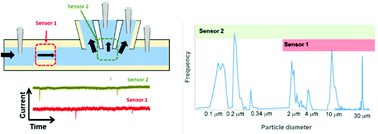Multi-resistive pulse sensor microfluidic device†
Abstract
Resistive pulse sensors have been used to characterise everything from whole cells to small molecules. Their integration into microfluidic devices has simplified sample handling whilst increasing throughput. Typically, these devices measure a limited size range, making them prone to blockages in complex sample matrixes. To prolong their life and facilitate their use, samples are often filtered or prepared to match the sample with the sensor diameter. Here, we advance our tuneable flow resistive pulse sensor which utilises additively manufactured parts. The sensor allows parts to be easily changed, washed and cleaned, its simplicity and versatility allow components from existing nanopore fabrication techniques such as glass pipettes to be integrated into a single device. This creates a multi-nanopore sensor that can simultaneously measure particles from 0.1 to 30 μm in diameter. The orientation and controlled fluid flow in the device allow the sensors to be placed in series, whereby smaller particles can be measured in the presence of larger ones without the risk of being blocked. We illustrate the concept of a multi-pore flow resistive pulse sensor, by combining an additively manufactured tuneable sensor, termed sensor 1, with a fixed nanopore sensor, termed sensor 2. Sensor 1 measures particles as small as 10 μm in diameter, whilst sensor 2 can be used to characterise particles as small as 100 nm, depending upon its dimensions. We illustrate the dual pore sensor by measuring 1 and 10 μm particles simultaneously.

- This article is part of the themed collections: 150th Anniversary Collection: Sensors for Human and Planetary Health and 150th Anniversary Collection: Microfluidics


 Please wait while we load your content...
Please wait while we load your content...